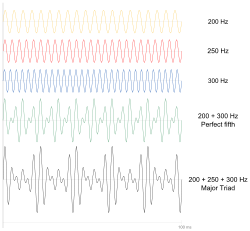- Major chord
-
major triad Component intervals from root perfect fifth major third root In music theory, a major chord (
 Play (help·info)) is a chord having a root, a major third, and a perfect fifth.[1] When a chord has these three notes alone, it is called a major triad. Some major triads with additional notes, such as the major seventh chord, may also be called major chords.
Play (help·info)) is a chord having a root, a major third, and a perfect fifth.[1] When a chord has these three notes alone, it is called a major triad. Some major triads with additional notes, such as the major seventh chord, may also be called major chords.A major triad can also be described as a major third interval with a minor third interval on top or as a root note, a note 4 semitones higher than the root, and a note 7 semitones higher than the root.
A minor chord (
 play (help·info)) differs from a major chord in having a minor third above the root instead of a major third. It can also be described as a minor third with a major third on top, in contrast to a major chord, which has a major third with a minor third on top. They both contain fifths, because a major third (4 semitones) plus a minor third (3 semitones) equals a fifth (7 semitones).
play (help·info)) differs from a major chord in having a minor third above the root instead of a major third. It can also be described as a minor third with a major third on top, in contrast to a major chord, which has a major third with a minor third on top. They both contain fifths, because a major third (4 semitones) plus a minor third (3 semitones) equals a fifth (7 semitones).An augmented chord is like a major chord, but with a raised fifth.
 play (help·info)
play (help·info)An example of a major chord is the C major chord, which consists of the notes C, E and G.
 A C major chord in its root position, first inversion, and second inversion, respectively
A C major chord in its root position, first inversion, and second inversion, respectively Play in root position (help·info)
Play in root position (help·info)In just intonation a major chord is tuned to the frequency ratio 4:5:6 (
 play (help·info)). This may be found on I, IV, V, ♭VI, ♭III, and VI.[2] In equal temperament it has 4 semitones between the root and third, 3 between the third and fifth, and 7 between the root and fifth. It is represented by the integer notation (0, 4, 7}. In equal temperament, the fifth is only two cents narrower than the just perfect fifth, but the major third is noticeably different at about 14 cents wider.
play (help·info)). This may be found on I, IV, V, ♭VI, ♭III, and VI.[2] In equal temperament it has 4 semitones between the root and third, 3 between the third and fifth, and 7 between the root and fifth. It is represented by the integer notation (0, 4, 7}. In equal temperament, the fifth is only two cents narrower than the just perfect fifth, but the major third is noticeably different at about 14 cents wider.The major chord, along with the minor chord, is one of the basic building blocks of tonal music and the common practice period. It is considered consonant, stable, or not requiring resolution. In Western music, a minor chord, in comparison, "sounds darker than a major chord."[3]
Major chord table
See also
Sources
- ^ Miller, Michael. The Complete Idiot's Guide to Music Theory, 2nd ed, p.113. [Indianapolis, IN]: Alpha, 2005. ISBN 1592574378.
- ^ Wright, David (2009). Mathematics and Music, p.140-41. ISBN 9780821848739.
- ^ Kamien, Roger (2008). Music: An Appreciation, 6th Brief Edition, p.46. ISBN 978-0-07-340134-8.
Chords By type - Major
- Minor
- Augmented
- Diminished
- Suspended
- Ninth
- Eleventh
- Thirteenth
- Upper structure
Added
/ omitted- Sixth
- Minor sixth
- Augmented sixth
- Power chord
- Lydian chord
- Seven six chord
By function Secondary- Secondary dominant
- Secondary leading-tone
- Secondary supertonic
With names - Elektra chord
- Farben chord
- Hendrix chord
- Mu chord
- Mystic chord
- Northern lights chord
- Petrushka chord
- Power chord
- Psalms chord
- So What chord
- Spider chord
- Tristan chord
- Viennese trichord
- Dream chord
Other - Common chord (music)
- Mixed interval
- Open chord
- Polychord
- Primary triad
- Quartal and quintal
- Slash chord
- Subsidiary chord
- Synthetic chord
- Tone cluster
Categories:- Chords
Wikimedia Foundation. 2010.


